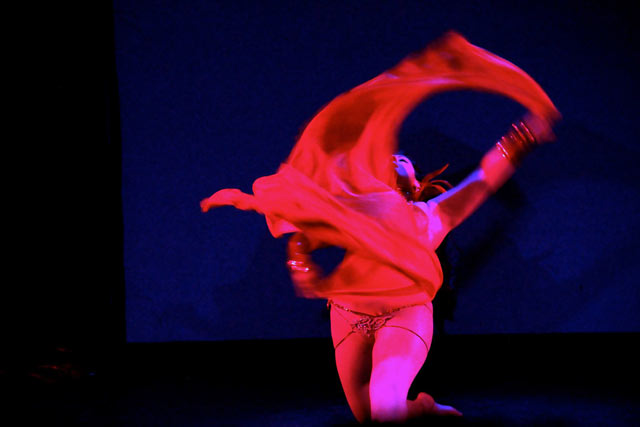It’s been nearly 10 years since choreographer and performance artist Ms. Cherry Galette met poet Leah Lakshmi Piepzna-Samarasinha at retreat for writers of color. At the one-week workshop Galette, who calls herself a "queer showgirl," and Piepzna-Samarasinha, a self-described "queer disabled Sri Lankan cis femme" performer bonded over the idea of starting a troupe made up of queer and trans people of color. In queer spaces, we faced so much racism [and] in straight people-of-color spaces, we faced so much homophobia," Galette says of why they formed the troupe, Mangos With Chili, in 2006.
On its website, Mangos With Chili is described as "the floating cabaret of queer and trans people of color bliss, dreams, sweat, sweets and nightmares." What that translates into is a wide variety of performance: there’s poetry, there’s burlesque, there’s acting. Since their first cabaret in 2007, they’ve presented the work of about 150 queer and trans people of color.
On November 15, in Dallas, you can catch Mangos With Chili at Facing Race, the biennial conference held by Colorlines’ publisher, Race Forward.
Cherry spoke with Colorlines about the group she co-founded and why burlesque is an important part of queer folks reclaiming their bodies.
How did Mangos With Chili start?
I met Leah Lakshmi Piepzna-Samarasinhawhile we were both attending VONA [Voices of our Nation] in the Bay Area in around 2005. We just got to talking about our mutual experiences around performing and that’s how rare it was to be part of an all QTPOC line-up. We just started building from there. We had different artistic visions, but I’ve always thought that’s been a strength of Mangos: We have come across such different contexts, experiences and creative platforms to tell queer and trans people-of-color stories through performance.
How important was it to have that space to incubate ideas for queer and trans performance?
I think about José Esteban Muñoz’s work. He has this thing that’s always guided me of queerness being a point of possibility and potentiality. Queers are so creative, and especially queer and trans people of color. We find courageous and creative ways to be together. We make shit happen. I think there’s so much power in us being physically together and exploring that potential.
When people go to your shows, what can they expect?
We’re a performance group that really embraces body positivity and wants to make a space for every body to be recognized. Along with that, we have a commitment to collective access. [We] want the stories of disabled queer and trans people of color showcased as well. Let me just be transparent about that: We’ve had our own learning curves around how to provide accessibility, in a good way. I just feel like it’s important to acknowledge it.
How did you get involved in the arts?
I grew up the daughter of wonderful musicians. During my formative years my parents were migrant farm workers, but they would come home and jam out and they would also play on the weekends. It was really beautiful to see people share and dance with that music. In terms of my own performative path, ironically I started as a writer. It’s the gateway drug. [Laughs.]
How did you start performing burlesque?
I kind of just went out there and did it. Back in 2004 a friend asked me to be a part of her show. That’s when I put together my first two burlesque pieces. It was wonderful. I got to engage with the audience and tell a story. It’s kind of funny because years later, a friend was helping me pack up all my things and she found this really pathetic looking pasty and said, "Oh, look! It’s your first pasty!"
Why is it important that people of color are performing burlesque?
It gives us a chance to redefine sexuality on our own terms, to be more erotic on our own terms. We’re able to address legacies of imperialism, colonization and slavery through our body’s movements. When you put your body on stage, you’re not only dealing with your own body and story, you’re telling other people’s stories who’ve had similar experiences.
Find out more about Galette’s work and her Facing Race workshop about the role of art in the lives of queer and trans people of color.
